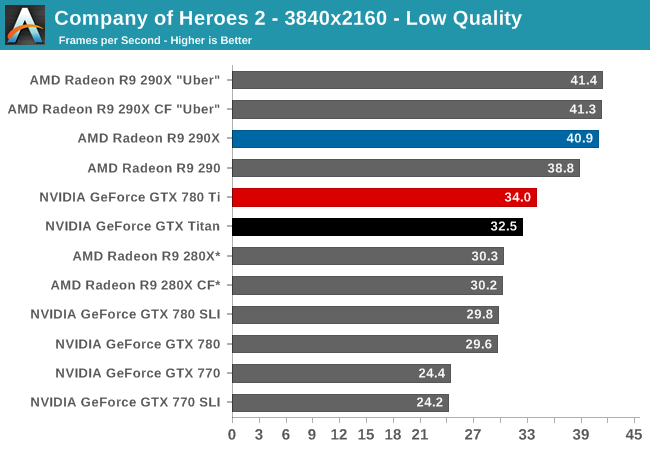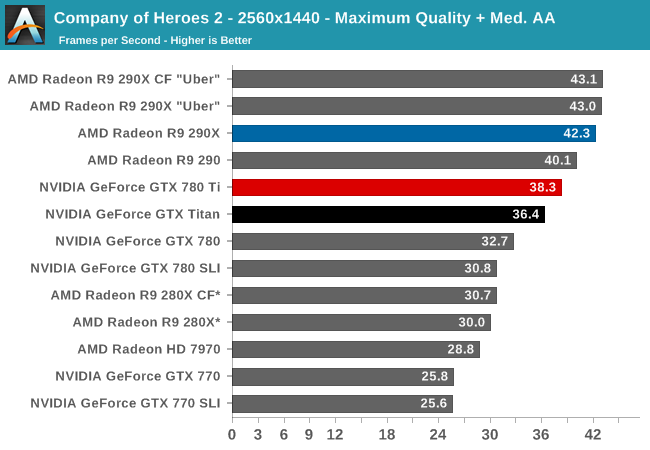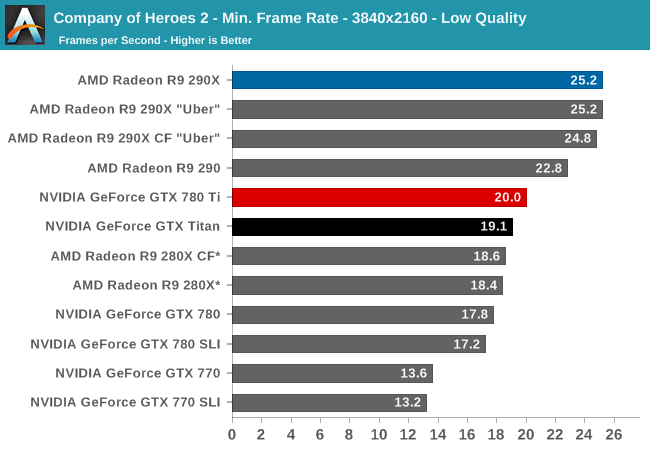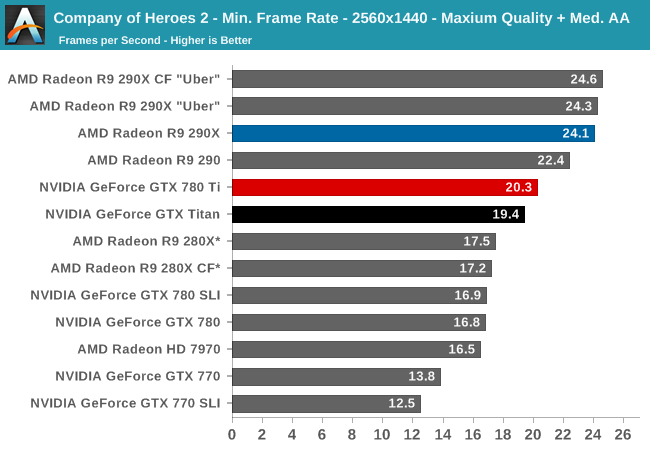The NVIDIA GeForce GTX 780 Ti Review
by Ryan Smith on November 7, 2013 9:01 AM ESTCompany of Heroes 2
Our second benchmark in our benchmark suite is Relic Games’ Company of Heroes 2, the developer’s World War II Eastern Front themed RTS. For Company of Heroes 2 Relic was kind enough to put together a very strenuous built-in benchmark that was captured from one of the most demanding, snow-bound maps in the game, giving us a great look at CoH2’s performance at its worst. Consequently if a card can do well here then it should have no trouble throughout the rest of the game.


Since Company of Heroes 2 is not an AFR friendly game, getting the best performance out of the game requires having the fastest GPU. While the GTX 780 Ti has a clear lead over the 290X across the average of our games, in this specific case it’s going to come up short, as AMD’s performance with this game is simply too high to be overcome without a significant performance advantage. Conversely this means that GTX 780 Ti and 290X are still close enough that NVIDIA won’t be able to sweep every game; in games where AMD still does exceptionally well, they’ll be able to close the gap and surpass the GTX 780 Ti.
Meanwhile, looking at a straight-up NVIDIA comparison, the GTX 780 Ti holds a slightly smaller than normal lead over its counterparts. At 5% faster than GTX Titan and 17% faster than GTX 780 it’s still the fastest of the cards, but it won’t pull ahead in this game by as much as it does elsewhere.


The minimum framerate story is largely the same. GTX 780 Ti is the fastest NVIDIA card, but it will trail the 290X by over 10% in both scenarios.










302 Comments
View All Comments
Wreckage - Thursday, November 7, 2013 - link
The 290X = Bulldozer. Hot, loud, power hungry and unable to compete with an older architecture.Kepler is still king even after being out for over a year.
trolledboat - Thursday, November 7, 2013 - link
Hey look, it's a comment from a permanently banned user at this website for trolling, done before someone could of even read the first page.Back in reality, very nice card, but sorely overpriced for such a meagre gain over 780. It also is slower than the cheaper 290x in some cases.
Nvidia needs more price cuts right now. 780 and 780ti are both badly overpriced in the face of 290 and 290x
neils58 - Thursday, November 7, 2013 - link
I think Nvidia probably have the right strategy, G-Sync is around the corner and it's a game changer that justifies the premium for their brand - AMD's only answer to it at this time is going crossfire to try and ensure >60FPS at all times for V-Sync. Nvidia are basically offering a single card solution that even with the brand premium and G-sync monitors comes out less expensive than crossfire. 780Ti for 1440p gamers, 780 for for 1920p gamers.Kamus - Thursday, November 7, 2013 - link
I agree that G-Sync is a gamechanger, but just what do you mean AMD's only answer is crossfire? Mantle is right up there with g-sync in terms of importance. And from the looks of it, a good deal of AAA developers will be supporting Mantle.As a user, it kind of sucks, because I'd love to take advantage of both.
That said, we still don't know just how much performance we'll get by using mantle, and it's only limited to games that support it, as opposed to G-Sync, which will work with every game right out of the box.
But on the flip side, you need a new monitor for G-Sync, and at least at first, we know it will only be implemented on 120hz TN panels. And not everybody is willing to trade their beautiful looking IPS monitor for a TN monitor, specially since they will retail at $400+ for 23" 1080p.
Wreckage - Thursday, November 7, 2013 - link
Gsync will work with every game past ad present. So far Mantle is only confirmed in one game. That's a huge difference.Basstrip - Thursday, November 7, 2013 - link
TLDR: When considering Gsync as a competitive advantage, add the cost of a new monitor. When considering Matnle support, think multiplatform and think next-gen consoles having AMD GPUs. Another plus side for NVidia is shadowplay and SHIELD though (but again, added costs if you consider SHIELD).Gsync is not such a game changer as you have yet to see both a monitor with Gsync AND its pricing. The fact that I would have to upgrade my monitor and that that Gsync branding will add another few $$$ on the price tag is something you guys have to consider.
So to consider Gsync as a competitive advantage when considering a card, add the cost of a monitor to that. Perfect for those that are going to upgrade soon but for those that won't, Gsync is moot.
Mantle on its plus side will be used on consoles and pc (as both PS4 and Xbox One have AMD processors, developpers of games will most probably be using it). You might not care about consoles but they are part of the gaming ecosystem and sadly, we pc users tend to get the shafted by developpers because of consoles. I remember Frankieonpc mentioning he used to play tons of COD back in the COD4 days and said that development tends to have shifted towards consoles so the tuning was a bit more off for pc (paraphrasing slightly).
I'm in the market for both a new monitor and maybe a new card so I'm a bit on the fence...
Wreckage - Thursday, November 7, 2013 - link
Mantle will not be used on consoles. AMD already confirmed this.althaz - Thursday, November 7, 2013 - link
Mantle is not used on consoles...because the consoles already have something very similar.Kamus - Thursday, November 7, 2013 - link
You are right, consoles use their own API for GCN, guess what mantle is used for?*spoiler alert* GCN
EJS1980 - Thursday, November 7, 2013 - link
Mantle is irrefutably NOT coming to consoles, so do your due diligence before trying to make a point. :)